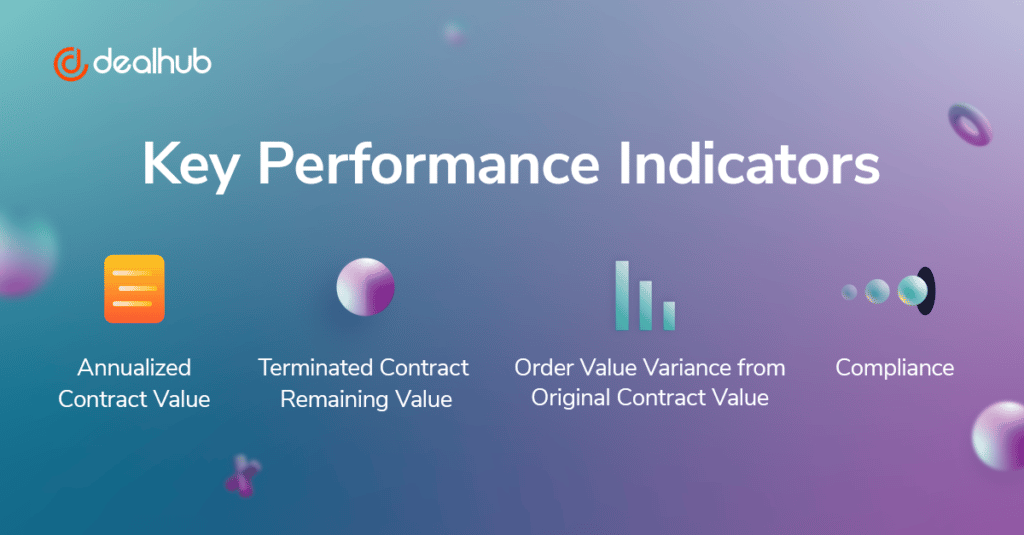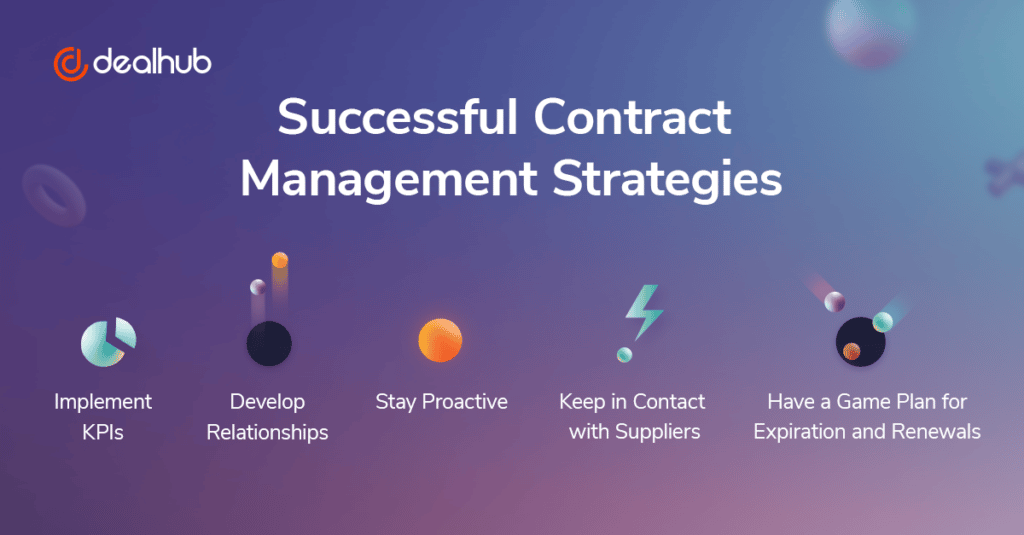
Contract Management Process
Contract management involves every stage of the contract management lifecycle, which includes:
- Requests: This phase includes information gathering and looking at details that are relevant to a potential agreement
- Authoring: Contract writers draw up the actual agreement in writing, including contract clauses, dates, and any essential information to the contract.
- Negotiation: This happens during the drafting phase and includes discussions over expectations and proposed revisions before the contract is final
- Signature: Each side signs that they agree to the contract.
- Obligations: Both parties recognize and fulfill what they agreed to by fulfilling deadlines and milestones and delivering promised items or services.
- Compliance: This includes oversight and ensuring that standards and guidelines are complied with. In this stage, reminders and late fees are issued. Getting to grips with charging late fees on invoices is important, and requires all parties to be up to speed with the part they need to play to fulfill the terms of the agreement.
- Renewals: The contract is renewed if both parties agree.
This is an overview of the lifecycle of contract management. There are essential details that will improve the contract management process in every phase.
Create a Template
When the parties are still in the research phase, and the discussions before an agreement are taking place, having a template ready to go when the two parties are prepared to sign is of the essence. Not having the right contract at a time when two parties are in an agreeable frame of mind can lead to lost opportunities. Getting access to contract templates is good preparation.
The challenge with creating documents that will be signed in to make them relevant to the situation, the industry, and in legal language that will make the contract enforceable.
Hastily drawn-up contracts involve bottlenecks and delays as the legal department identifies holes and problems. A relevant contract composed of inaccurate standard language saves time and can facilitate an agreement.
If no template suits the current agreement precisely, it is possible to improve the template without interfering with its basic structure or legal status. If revisions and improvements need to be made, check with legal experts that no revisions interfere with the contract’s legal status.
After researching templates, making improvements, and paying particular attention to structure and agreements, the next step is authoring the contract.
Write the Contract
Of course, not every word of a contract is written from scratch. Contracts often include several boilerplate text passages or passages that can be reused from one contract to the next if the stipulations are the same.
As with any template revisions, it is essential to check with legal experts to ensure that none of the boilerplate text is contradictory or involves something other than what both parties intend to agree on. The following are examples of common boilerplate texts in contracts.
Choice of Law involves both parties agreeing that the contract will be enforced according to a specific jurisdiction. This is particularly relevant if the parties are located in different states or countries.
Choice of Forum controls where a suit will be brought if there is a legal dispute between parties. It gives a court “personal jurisdiction” and provides a venue to judge the dispute.
Arbitration involves so many different elements depending on the contract. The boilerplate arbitration text could include a variety of issues such as choice of administrator, number of arbitrators, issues in a potential trial, duration of the trial, and parameters and format of the award.
Severability outlines situations in which the contract may be unenforceable. It may leave parts of the agreement intact or allow the entire contract to be null and void.
Integration states that the contract is in accord with what the parties know at the time of signing the contract and supersedes prior discussions.
Confidentiality is an agreement that the parties are not to disclose specific types of information. The clause can state certain exceptions and outline penalties if such a disclosure is made.
A contract manager is responsible for overseeing compliance with the terms of a contract. It is relevant to consider this during the writing stage because the contract’s clarity and careful consideration of the wording before it is signed can prevent compliance issues later on.
One or more parties may not understand what is required because of certain ambiguities in the contract’s wording or can find loopholes to get around certain previsions. Looking at a contract carefully, consulting with legal experts, and ensuring it is airtight can make compliance easier.
When drawing up a contract, being proactive about compliance includes a system of notifications to ensure the terms are met on time and an official system to track compliance regularly. If both parties agree to an oversight at the beginning, there will be less opportunity to dispute it later.
Contract Repositories are the advanced alternatives to old-fashioned filing cabinets. They make information easier to locate, protect, and organize. Spreadsheets may seem like a reliable way to track contracts, but manual functions’ reliance may create the risk of missing important milestones and deadlines.
Tools provide notifications coordinated with previously agreed-upon dates and make it simple to locate and share information.
Defining and managing metrics is another task of a contract manager. Identifying what metrics are most essential to fulfilling the terms of a contract and keeping track of these numbers is part of ensuring compliance. Cost, timeliness, satisfaction, and safety are priorities for any business, and looking at associated metrics ensures targets will be met.
Audits and examining iterations of the contract ensure that the parties are on the same page. Keeping tabs on performance data makes troubleshooting easier. The audit sessions are inspired by the goal of continual improvement and helping each party refine what is meant by the agreement’s terms.
Review the Contract
When the contract is drawn up and discussed, it is essential to examine it carefully before obtaining signatures. Look for the following:
- Key Clauses & Terms
- Termination and Renewal
- Clear language
- Dates and deadlines
Ensure that all clauses and terms are clearly defined and appropriately emphasized. Major points should be stated in a way that they are shown to be primary rather than secondary points. The contract should state clearly what conditions are present and the procedures needed for termination and renewal.
Proofread and edit the contract to ensure that the language is clear and free of any ambiguities. The contract should be accessible to all signers. Finally, the names and information should be confirmed as correct, and dates and deadlines clearly stated. Small errors can lead to significant misunderstandings.
Approve the Contract
When the contract has been written, revised, proofread, and when relevant experts have looked it over, approval and signing is the next step. The last steps toward acceptance involve:
- Review by correct people
- Communication and redlining
- Audit trail
- Visibility for stakeholders
This step involves the contract being passed around to different parties. Automating the process saves time and can increase the chances of prompt approval. Unfortunately, many deals pass by because of the inefficient manual passing of documents from one point to another. Therefore, tools that automate the process are recommended.
The contract should be reviewed by legal experts as well as the parties involved. They may discuss specific terms in the contract and may request clarification. A contract manager keeps track of the audit trail and should confirm who requested approval or clarification at which points. Keeping track of this process provides visibility for stakeholders who also have a vested interest in the deal succeeding.
Related article: Why is Contract Management Software Important to Compliance?
Contract Performance
There are several ways to measure performance in connection with contracts. One way is to collect information on what is working and what isn’t using performance indicators:

- Annualized contract value (ACV)
- Terminated contract remaining value (TRV)
- Order Value Variance from Original Contract Value (OVV)
- Compliance
The annualized contract value is a useful indicator for recurring contracts because it measures the value of contracts that are renewed annually. It also measures routine contracts’ revenue compared to new contracts and estimated losses from non-renewed or terminated contracts.
Terminated contract remaining value prevents revenue losses because it calculates unpaid invoices and outstanding fees. This indicator measures performance and compares the value of ongoing contracts with terminated contracts.
Order Value Variance measures performance and points out areas that can be improved, including communication and errors. This indicator provides a rating of under 5% as acceptable and 10% and over revealing a need for improvement.
Subscription Management
Managing subscriptions requires organizational skills that deal with scale while focusing on details and encouraging renewals. The keys to successful subscription management are to:
- Simplify
- Guide
- Control
Simplifying subscriptions standardize packages and payment terms, customizes pricing, personalizes billing, and communicates new services. Guide with a Playbook and a step-by-step approach to the process guided by rules and logic to standardize subscription. Make changes to the Playbook as needed.
Control processes such as offering upsell, discounts, and price reductions on renewals. Put renewal notices on a schedule, forecast revenue accurately, and improve customer engagement with strategies that encourage subscription renewals.
Related article: How to Increase Revenues Through Subscriptions
Contract Renewal
Contract renewal occurs when a contract is about to expire, and the parties decide whether to let the contract expire or renew it for a longer period of time. They may choose to renew the contract on the same terms or may want to renegotiate the terms.
Many contracts are renewed automatically, but depending on the type of contract. This is a convenient way to continue a contract that has provided value. It is more convenient and faster than manual processes. The manual method of renewing contracts does allow time to review the contract, but this could also be possible with automation if there are reminders in place.
Whether contract renewal is manual or automated, it is imperative to send reminders within 30 days of a contract expiring. This will give the parties a chance to review the contract and request information or clarification ahead of the due date.
Successful Contract Management Strategies
Contract management is a complex process that involves many moving parts. The following are essential tips for improving the contract management process:

- Implement KPIs
KPIs or Key Performance Indicators are ways of monitoring how much value each party is providing. Incorporating these metrics into the contract can ensure that performance remains consistent and efficient.
- Develop Relationships
Contracts are not a replacement or an alternative to a business relationship. Ideally, the parties already have a strong working relationship, and a contract is a way of cementing that connection. If the parties are not familiar with each other, a solid contract can build trust and foster a long-term working relationship.
- Stay Proactive
Once the contract is signed, the work isn’t over. Ongoing and thorough management of the contract is the best way to spot potential problems before they happen. Monitoring contract-related activities can pinpoint issues and provide opportunities for improvement.
- Keep in contact with suppliers
Reviewing contracts with suppliers regularly and staying on the same page can prevent interruptions and misunderstandings during times that may be crucial to the business. Create a plan of action with suppliers to improve performance and ensure delivery according to the timeline.
- Have a Game Plan for Expiration and Renewals
When drawing up a contract, pay careful attention to circumstances in which a contract may become no longer enforceable and issues surrounding expiration. Contact parties well in advance of expiry and consider using automation for instant renewal.
Improve Contract Management with DealHub
Contract management is essential to maximizing the revenue impact of your sales pipeline. DealRoom is an advanced technology that empowers leaders to take control of their entire contract lifecycle.
DealRoom brings next-generation sales technology to your organization:
- Simplify contract creation
- Use pre-approved templates to minimize errors
- Standardize approval workflows
- Streamline revisions
- Receive real-time engagement notifications
- Integrate e-Signature







